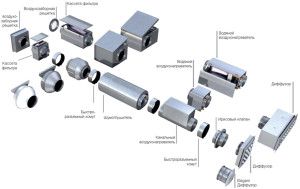
There are many options for arranging ventilation systems for various types of premises. They differ in the principle of air movement, the shape and material of the air ducts, and the number of fittings. But, regardless of the device, all ventilation systems perform the same function: supplying fresh air and removing waste air.
Ventilation in an apartment building
Over the past decade, the ventilation system in multi-storey buildings has undergone significant changes.
Ventilation in Khrushchev
The ventilation device in a multi-storey Khrushchev building is such that the movement of air is based only on the laws of physics. Warm and humid air from apartments tends to find a way out. In apartments, a vacuum is created, which is replenished with clean air that penetrates through the vents or cracks in the doors. Ventilation shafts have been built for diversion.
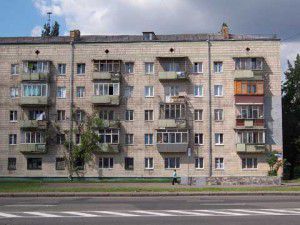
The mine runs through all floors and is located between the bathroom and the kitchen. Exhaust ventilation grilles are installed in the walls under the ceiling, they go directly into the shaft without any auxiliary air ducts.
Such a ventilation device for a panel house is very simple, but not effective enough.
Minuses:
- air movement directly depends on temperature and pressure “overboard”. The best draft in winter, when the temperature drop is maximum, in summer, ventilation is practically inactive;
- on the last floors, the thrust is very low;
- often the phenomenon of "overturning draft" in which odors from the mine are drawn into the apartments. Residents of the upper floor are especially affected by it. The situation is aggravated by the fact that only a ventilation grill separates the mine and the apartment;
- if the windows in the apartment are closed hermetically, there will be no outflow through the ventilation either.
Ventilation in panel high-rise buildings
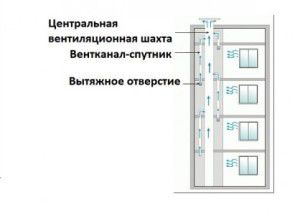
The principle of operation is similar, but the ventilation device in multi-storey buildings of a later construction is slightly different.
Individual air ducts-satellites are led to the common exhaust shaft from each apartment, which serve to disperse the air. To save space, they are connected to the central shaft through the floor. With such an exhaust ventilation device, it is possible to conduct satellite channels not only from each apartment, but also from each room.
Although the scheme is more complex, all the disadvantages of the natural ventilation device of a panel house are present in it.
Ways to improve the ventilation of the apartment
Residents of the overwhelming number of apartment buildings are faced with a lack of air exchange:
- windows in the kitchen "cry";
- slopes are covered with mold;
- dust accumulates very quickly in the apartment;
- the smell of food from the kitchen spreads into the living rooms.
These are the main signs of problems with the ventilation device of the apartment.
Possible reasons:
- Destruction or clogging of the exhaust shaft;
- Lack of air flow.
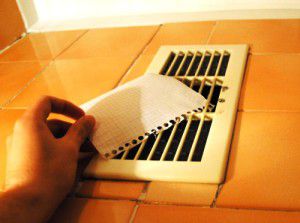
During the years of spontaneous redevelopment, many residents tried to equip the kitchen area with a ventilation duct in the apartment. Some simply disassembled it, tightly blocking the air passage. Others tried to change the ventilation duct in the apartment.Not understanding the general arrangement of exhaust ventilation, they left the residents of the lower floors without an exhaust hood. There is only one way out of the situation - the restoration of the ventilation ducts in each apartment of the riser.
Ventilation pipes are common property. Therefore, it is forbidden to destroy them or alter them in any way.
Garbage from the shaft of the ventilation shaft is removed only by specially trained people. Residents can only clean the area adjacent to the exhaust grilles of the kitchen and toilet. Start your search for a solution by thoroughly cleaning your kitchen ventilation grill.
If the apartment has PVC windows without supply valves, the natural supply and exhaust ventilation is broken. Air is not supplied, so there is no extractor hood. The problem is solved by installing the air inlet on the window sash or in the wall. Check the draft in the exhaust grilles beforehand. If there is no venting, the supply valve is useless.
Traction check
- Open all the vents in the apartment.
- Take a smooth, palm-sized piece of paper.
- Place it on your kitchen fume hood.
If the sheet is held, everything is in order. Otherwise, it is necessary to check the condition of the ventilation shaft.
Mechanisms for ventilation of the apartment
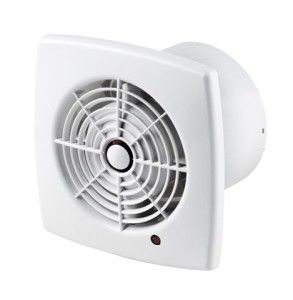
The natural ventilation device of an apartment can be improved by adding simple and inexpensive mechanisms.
Cooker hood. It is successfully used by many residents. It is installed above the hob and turns on when needed. There are active and passive hoods. The former take air out through the duct. The latter are just filtering. Installation and selection of an active hood requires compliance with a number of rules:
- it is better to discharge the exhaust air directly to the street, and not to the general ventilation of the house;
- when connecting the air duct to the common house system, the ventilation grill in the kitchen must not be blocked;
- too powerful a hood can disrupt the operation of general ventilation;
- the optimal performance of the kitchen fan is 200 cubic meters per hour.
Exhaust fan. Installed instead of the exhaust grille. Its power is selected depending on the purpose of the room and its area. But most household exhaust fans have a capacity of up to 250 cubic meters per hour. There are automatic devices for exhaust ventilation that are triggered when humidity rises or a person appears. The mechanisms are also successfully used in the ventilation of private houses.
Private house ventilation
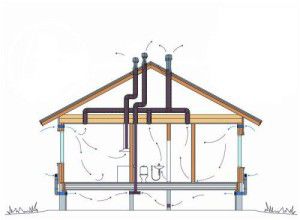
Even in ancient times, ventilation was arranged in private houses. A chimney was used as a powerful exhaust duct. And the air flow was provided by the cracks between the logs of the log house. Otherwise, you will not light a fire in the house. The load on this ventilation was low. All cooked in the same oven, washed in a separate room in the bath. And the walls themselves, made of "living", breathing wood, filtered the air. It’s not like that today. Modern houses resemble a thermos, they are built with materials aimed at maximizing heat conservation. A country house without properly arranged ventilation will rapidly collapse, become covered with mold, posing a threat to the health of its residents.
There are two types of ventilation devices for country houses:
- Passive or natural;
- Active or mechanical.
As a third option, a combined ventilation device system can be considered.
Natural ventilation suitable for country cottages, which are used mainly in the warm season. Opened all the windows and doors - here's the ventilation. A warm breeze blows through all the rooms. The device is simple and sufficient for ventilation of a small private house.
Owners of houses with "summer" ventilation, arriving at the dacha in early spring, are faced with a musty, heavy smell.You can slightly improve the ventilation device in a country house. Install louvered vents in the walls at different levels. This way you can regulate the air flow, and the house will not be left without ventilation even in winter.
A few more useful tips for optimizing the supply and exhaust natural ventilation device:
- use various options for opening vents and windows. With completely open windows in the house, drafts cannot be avoided;
- do not forget to open windows on all floors. In summer, the hottest part of the cottage is often the attic;
- equip all windows with mosquito nets;
- even with the simplest ventilation device in a private house, take care of ventilating the floor. Otherwise, it will pull from the bottom with dampness, and the floor covering will rot.
Mechanical ventilation ideal for large country houses.
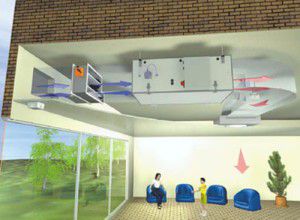
The most comfortable cottages are equipped with mechanical draft ventilation. These are powerful, bulky and expensive devices. They combine the functions of ventilation, air conditioning and heating. To accommodate some modules, you may need special niches, openings in the walls or channels in the floors. Therefore, they are calculated and planned at the stage of building design.
The duct system is hidden in the ceilings or decorated during finishing. And ventilation grilles can be an additional decoration, a highlight of the interior. They are made from a wide variety of materials and designs. You can make the air supply points completely invisible by hiding them in a multi-level ceiling or lowering them to floor level.
Before being supplied to living rooms, the air is given optimal parameters: temperature, humidity, content of impurities. Exhaust air is drawn from storage rooms, kitchens, laundry rooms, and bathrooms. Mechanisms are responsible for all movement.
A somewhat simplified and cheap scheme - combined ventilation device in a country house... If the cottage is located in an ecologically clean place, there is no need to process the supply air. It is quite enough to provide a good exhaust air, and clean air will flow through the supply valves or open vents. This method is good for small private houses.
Exhaust fans are installed in the kitchen and bathroom. The convenience of the supply and exhaust ventilation device in a private house is the ability to exhaust air directly to the street, through a hole in the wall. No air ducts are needed for this.
Barn ventilation
In the barn, you can arrange ventilation on a natural or mechanical draft.
Natural
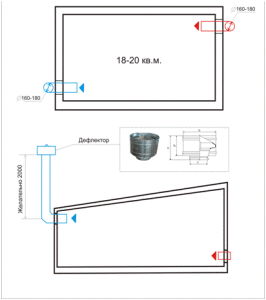
To begin with, you should think about the placement of the supply and exhaust ducts.
Channels can be made with a rectangular or circular cross-section, the material of the pipes also does not matter much, but with plastic ones it is easier to work and they are cheaper.
In the ventilation of the barn, arranged on natural draft, weather conditions play an important role. And the performance of such a scheme is not high. However, this is often enough for a barn.
The device of the supply side of the ventilation is as follows: a hole is made 20 cm from the floor, into which an air duct with a diameter of 100 - 150 mm is inserted. Outside, the outlet of the pipe is covered with a grate from small animals, and from the inside, you can install blinds that regulate the intensity of the inflow. In winter, such a supply ventilation device will save you from cooling.
Unlike the supply ventilation device, the exhaust unit is installed under the roof, as high as possible. To avoid stagnant corners in the room, the opposite wall is selected.
The difference in height between the inflow and outflow must be at least 3 m. Otherwise, it will not pull. Therefore, many take out the chimney above the roof level and cover the head with a ventilation hood. You can install a deflector instead of an umbrella to increase traction.
Mechanical
The mechanical scheme has undeniable advantages over the natural supply and exhaust ventilation of the barn:
- gives a guaranteed result;
- no need to carefully choose the location for the supply and exhaust ducts.
In order for the supply and exhaust fans to do their job perfectly, they should be positioned opposite each other and preferably at different heights. But, even installed on the same wall, they do their job.
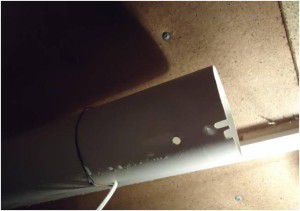
Cons of a mechanical barn ventilation device:
- additional costs for equipment and operation;
- the need to conduct electricity to each fan and make waterproofing;
- ventilation will not work in the absence of light.
Condensation can build up in the exhaust duct and cause a short circuit.
Here are some tips to help you avoid it:
- make the pipe in which you plan to install the fan a little longer;
- drill a series of holes to drain the moisture.
And one more tip: connect the power supply to the fans through a double switch. If necessary, you can start the extract and supply separately.
Knowing the basic principles of work, it is easy to independently deal with the ventilation device in an apartment, shed or garage. Leave the solution to the problems of air exchange in a cottage or apartment building for professionals.








